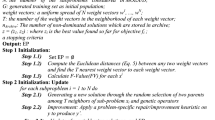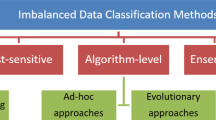Abstract
A new hybrid scheme of the elliptical basis function neural network (EBFNN) model combined with the cooperative coevolutionary algorithm (Co-CEA) and domain covering method is presented for multiclass classification tasks. This combination of the Co-CEA EBFNN (CC-EBFNN) and the domain covering method is proposed to enhance the predictive capability of the estimated model. The whole training process is divided into two stages: the evolutionary process, and the heuristic structure refining process. First, the initial hidden nodes of the EBFNN model are selected randomly in the training samples, which are further partitioned into modules of hidden nodes with respect to their class labels. Subpopulations are initialized on modules, and the Co-CEA evolves all subpopulations to find the optimal EBFNN structural parameters. Then the heuristic structure refining process is performed on the individual in the elite pool with the special designed constructing and pruning operators. Finally, the CC-EBFNN model is tested on six real-world classification problems from the UCI machine learning repository, and experimental results illustrate that the EBFNN model can be estimated in fewer evolutionary trials, and is able to produce higher prediction accuracies with much simpler network structures when compared with conventional learning algorithms.





Similar content being viewed by others
Explore related subjects
Discover the latest articles, news and stories from top researchers in related subjects.References
Xu Y, Zhang D, Jin Z (2006) A fast Kernel-based nonlinear discriminant analysis for multi-class problems. Pattern Recognit 39(6):1026–1033
Freund Y, Mason L (1999) The alternating decision tree learning algorithm. In: Proceedings of the 16th international conference on machine learning, pp 124–133
Hyun-Chul K, Zoubin G (2006) Bayesian Gaussian process classification with the EM-EP algorithm. IEEE Trans Pattern Anal Mach Intell 28(12):1948–1959
Luo JC, Leung Y, Zheng J, Ma JH (2004) An elliptical basis function network for classification of remote sensing images. J Geograph Syst 6:219–236
Gao DQ, Yang GX (2002) Adaptive RBF neural networks for pattern classifications. In: Proceedings of the 2002 international joint conference on neural networks (IJCNN ’02), vol 1, pp 846–851
Fu XJ, Wang LP (2003) Data dimensionality reduction with application to simplifying RBF network structure and improving classification performance. IEEE Trans Syst Man Cybern B 33(3):399–409
Mimura M., Fukukawa T (1999) A nonlinear equalizer based on estimation of RBF’s centers. In: Proceedings of the 1999 IEEE international symposium on circuits and systems, vol 3, pp 231–234
Mak MW, Kung SY (2000) Estimation of elliptical basis function parameters by the EM algorithms with application to speaker verification. IEEE Trans Neural Netw 11(4):961–969
Blanco A, Delgado M, Pegalajar MC (2001) A real-coded genetic algorithm for training recurrent neural networks. Neural Netw 14:93–105
Sarimveis H, Alexandridis A, et al. (2004) A new algorithm for developing dynamic radial basis function neural network models based on genetic algorithms. Comput Chem Eng 28:209–217
Mitchell TM (2003) Machine learning. China Machine Press, Beijing
Chen S, Cowan CFN, Grant PM (1991) Orthogonal least squares learning algorithm for radial basis function networks. IEEE Trans Neural Netw 2:302–309
Zhu Q, Cai Y, Liu L (1999) A global learning algorithm for a RBF network. Neural Netw 12:527–540
Leonardis A, Bischof H (1998) An efficient MDL based construction of RBF networks. Neural Netw 11:963–973
Zhao QF, Higuchi T (1996) Evolutionary learning of nearest neighbor MLP. IEEE Trans Neural Netw 7:762–767
Iorio A, Li X (2002) Parameter control within a co-operative co-evolutionary genetic algorithm. In: Proceedings of the seventh conference on parallel problem solving from nature, pp 247–256
Eriksson R, Olsson B (1997) Cooperative coevolution in inventory control optimisation. In: Proceedings of the third international conference on artificial neural networks and genetic algorithms, pp 583–587
Potter M, DeJong K (1998) The coevolution of antibodies for concept learning. In: Proceedings from the fifth international conference on parallel problem solving from nature, pp 530–539
García-Pedrajas N, Hervás-Martínez C, Ortiz-Boyer D (2005) Cooperative coevolution of artificial neural network ensembles for pattern classification. IEEE Trans Evol Comput 9:271–302
Potter M, DeJong K (2000) Cooperative coevolution: an architecture for evolving coadapted subcomponents. Evol Comput 8:1–29
Li MQ, Kou JS et al (2002) The basic theories and applications in GA. Science Press, Beijing
Tian J, Li MQ, Chen FZ (2006) GA-RBFNN learning algorithm for complex classifications. J Syst Eng 21:163–170
García-Pedrajas N, Colin F (2007) Immune network based ensembles. Neurocomputing 70(7–9):1155–1166
Friedman N, Geiger D, Goldszmidt M (1997) Bayesian network classifiers. Mach Learn 19(4):131–163
Eklund WP (1999) A comparative study of public domain supervised classifier performance on the UCI database. Proc SPIE 3695:39–50
Dietterich TG (2000) An experimental comparison of three methods for constructing ensembles of decision trees: bagging, boosting, and randomization. Mach Learn 40:139–157
Cantú-Paz E, Kamath C (2003) Inducing oblique decision trees with evolutionary algorithms. IEEE Trans Evol Comput 7: 54–68
Draghici S (2001) The constraint based decomposition (CBD) training architecture. Neural Netw 14:527–550
Webb GI (2000) Multiboosting: a technique for combining boosting and wagging. Mach Learn 40:159–196
Sotiris BK, Panayiotis EP (2005) Logitboost of simple bayesian classifier. Informatica 29(1):53–60
Frank E, Witten IH (1998) Generating accurate rule sets without global optimization. In: Proceedings of the fifteenth international conference on machine learning, pp 144–151
Frank E, Pfahringer B (2006) Improving on bagging with input smearing. PAKDD Lect Notes Artif Intell 3918:97–106
Jing YS, Pavlovic V, James MR (2005) Efficient discriminative learning of Bayesian network classifiers via boosted augmented Naive Bayes. In: Proceedings of the 22nd international conference on Machine learning. ACM international conference proceeding series, vol 119, pp 369–376
Holmes G, Trigg L (1999) A diagnostic tool for tree based supervised classification learning algorithms. In: Proceeding of sixth international conference on neural information processing (ICONIP’99), vol II, pp 514–519
Bosman PN, Thierens D (2003) The balance between proximity and diversity in multiobjective evolutionary algorithms. IEEE Trans Evol Comput 7:174–188
Acknowledgments
The work was supported by the National Science Foundation of China (Grant No. 70171002, No. 70571057) and by the Program for New Century Excellent Talents in Universities of China (NCET-05-0253).
Author information
Authors and Affiliations
Corresponding author
Rights and permissions
About this article
Cite this article
Tian, J., Li, M. & Chen, F. A hybrid classification algorithm based on coevolutionary EBFNN and domain covering method. Neural Comput & Applic 18, 293–308 (2009). https://doi.org/10.1007/s00521-008-0182-6
Received:
Accepted:
Published:
Issue Date:
DOI: https://doi.org/10.1007/s00521-008-0182-6




